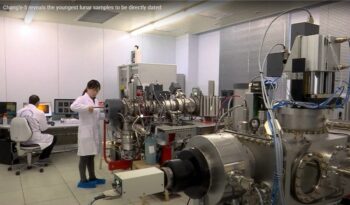Moon rock and regolith brought back to Earth by China’s Chang’e-5 lunar sample mission suggests that the samples are a new type of lunar basalt, different from those collected during previous U.S. Apollo and former Soviet Union robotic Luna missions.
The first batch of lunar soil samples were sent to 31 labs of 13 Chinese research institutions last July. Chinese researchers analyzing the lunar collectibles report they have dated the youngest rock on the Moon at around 2 billion years in age, extending the “life” of lunar volcanism 800-900 million years longer than previously known.
China’s Chang’e-5 probe returned to Earth on December 17, 2020, parachuting back a total of around 1.73 kilograms of lunar samples.
Magmatic history
A research team analyzed more than 50 uranium-rich rock fragments extracted from lunar basalt and dated the youngest rock on the Moon at about 2 billion years old. Previously, the youngest dated rock from the Apollo and Luna missions and lunar meteorites was around 2.8-2.9 billion years old.
According to Ouyang Ziyuan, an academician of the Chinese Academy of Sciences (CAS), the Moon formed 4.5 billion years ago and magmatic activities were not recorded in the lunar mantle until around 4 billion years ago.
“There were no magmatic activities recorded in the lunar mantle from 3 billion years ago until now. There are two issues concerning the history of the Moon,” Ouyang said via China Central Television (CCTV). “We are not clear about its history before 4 billion years ago and after 3 billion years ago. How we can make breakthrough to restore the true evolution history of the Moon is an important task of scientists. I think it is quite an achievement to extend the history of magmatic activities from 3 billion years ago to 2 billion years ago,” he added.
Interesting phenomenon
Li Xianhua, another CAS academician, told CCTV:
“Ascertaining this age correctly is very important for another dating technique by using impact craters. Using this method, we can date other regions where the lander cannot reach and other planets in the solar system. The age is the most basic parameter for us to know an object, a planet,” said Li.
Triggers of the latest volcanic activities on the Moon have always been a mystery. There are now two possible explanations among the scientific community.
- The magmatic source was rich in radioactive heat production elements that could provide heat source for melting magma in the Moon’s mantle and drive eruptions.
- The low melting point of the lunar mantle due to high water content resulted in a prolonged duration of volcanic activities.
However, studies of the Chang’e-5 specimens show that the samples are not rich in hot radioactive elements and are exceptionally dry.
“There are neither so many radioactive elements nor water, so what triggered the melting becomes an interesting issue. So we will continue to study this interesting phenomenon,” Li said.
China/France cooperation
According to Ecns.cn — the official English-language website of China News Service (CNS) — the Chinese Academy of Sciences has reached initial consensus with the French Centre National d’Etudes Spatiales (CNES) and French National Centre for Scientific Research a joint research initiative to study lunar samples collected by China’s Chang’e-5 mission, Academy officials said at press conference Tuesday.
China and France will carry out complementary cooperation in the form of personnel exchanges and joint research projects, according to Ecns.cn in detailing the conference.
Video & published papers
Go to these videos focused on lunar sample studies, at:
To view a set of research articles by Chinese lunar experts, published October 19, 2021 in Nature, go to:
“Non-KREEP origin for Chang’E-5 basalts in the Procellarum KREEP Terrane,” at:
https://www.nature.com/articles/s41586-021-04119-5
“A dry lunar mantle reservoir for young mare basalts of Chang’E-5,” at:
https://www.nature.com/articles/s41586-021-04107-9
“Two billion-year-old volcanism on the Moon from Chang’E-5 basalts,” at:





